17-19 May 2014. A few thousand years ago, or more likely in some mythological land where time has no meaning, Aphrodite, the ancient Greek goddess of love and fertility, arose from the sea near Paphos at Petra tou Romiou, just like Honey Ryder in the movie Dr. No, only without the suggestive white bikini. Aphrodite’s name arose from aphros, the Greek word for (sea) foam. Like most ancient Greek gods and goddesses there are several versions of her miraculous beginnings. This is the story of the Cypriot cult of Aphrodite. The story goes like this: Kinyras was the priest-king and first consort of Aphrodite. They had a beautiful daughter called Myrrha. Aphrodite, the original spiteful mother, was jealous of her daughter’s beauty and turned her into a bush. Adonis was born from the wood of the bush and became Aphrodite’s lover. I don’t know what happened to Kinyras. Perhaps he found solace with the ritual sacred “prostitutes” in the temple.
Like most stories of the gods, it was written by the people, and reflects their society at the time. The men of the Kinyradai Dynasty “married” Aphrodite by having sex with the sacred “prostitutes” at the temple, and then married their own daughters when their wives died. There was never a shortage of “prostitutes” since every young woman had to go to the temple at least once and have sex with a stranger who threw money at her feet while invoking the goddess. The less beautiful girls could wait years to fulfill their duty before they were chosen.
The remains of the Sanctuary of Aphrodite are situated some 14 kilometers from Paphos. It is believed to have been a site of worship of fertility goddesses as long ago as 3800 BC. By 1500 BC the temple to Aphrodite had been erected, and the town of Palai (old) Paphos grew up around the sanctuary. The cult became so well established that Old Paphos developed into a notable Cypriot City-state and the most celebrated place in the ancient world for the worship of Aphrodite. The glory days of the sanctuary and the cult of Aphrodite lasted several hundred years. It was one of the leading places of pilgrimage of the ancient world. Not much more remains today than the hallowed ground on which it stood. In the 4th century the Roman Emperor Theodosius outlawed paganism, from Byzantine times the local population used it as a “quarry” for building materials, and in the Middle Ages a sugar-milling factory was built on the foundations, destroying nearly everything that was left above knee height. Like everything else on this earth: it arises, it falls away.

Back now in the 21st century – a snippet from Don’s journal: The drive from Troödos to Paphos took us first on back roads through beautiful mountain country and then across a valley to see the ruins of the Aphrodite temple at Kouklia before heading along the A6 into Paphos. Finding our hotel was a bit of a challenge, but we managed to get there eventually without much stress. The owner, Andrea, who looks a bit like a pirate, with long grey hair, an eye patch and a pronounced limp, was very welcoming, and gave us a free upgrade to a room with a sea-view on the fourth floor. There was an upmarket restaurant with a wonderful view of the ocean right across from the hotel, and we ate most of our meals there: good food at reasonable prices, within easy walking distance. Paphos from our room.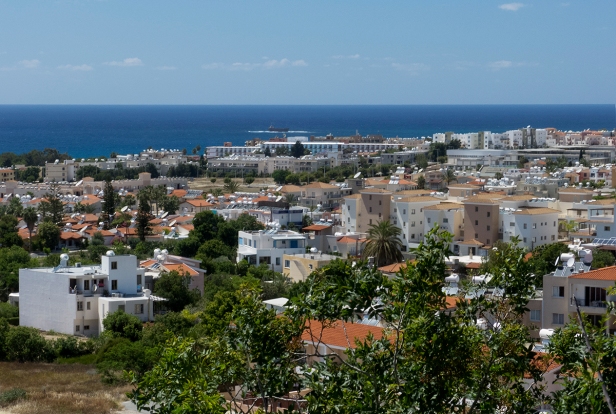
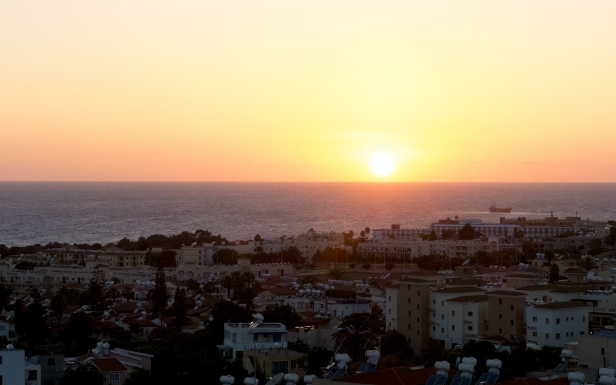
Prior to Cyprus becoming part of the Byzantine Empire in 395 AD it had been colonized by the Greek Myceneans, solidified into 10 city-states, conquered by the Assyrians, declared its independence from the Assyrians, conquered by the Egyptians, declared allegiance to the Persians, rebelled against the Persians, re-conquered by the Persians, conquered by the Phoenicians, conquered yet again by the Persians, rebelled again, aligned with the Macedonians and Alexander the Great, and conquered by the Greek Ptolemaic Empire of Egypt. And that only takes us to 58 BC when it became a province of Rome. Plus there were major earthquakes that destroyed much of the island’s cities in 332, 342 and 365 AD. Quite near Paphos is a huge desert wasteland overlooking the eternally blue Mediterranean Sea. And beneath it are the tombs of the aristocracy dating from about 300 BC until about 300 AD, initially during the time when Cyprus was part of the Ptolemaic Empire and later when it became part of the Roman Empire.
This huge underground necropolis, dug out of the solid rock, contains tombs for over one hundred Ptolemaic aristocrats, and in the Greco-Egyptian style of the time they were built as houses for the dead, though big enough to be houses for the living, with separate rooms, Doric columns, and walls adorned with frescoes. Although the site is known as the Tombs of the Kings, there’s no evidence that royalty were ever buried there. It was a fascinating exploration as we climbed down steep steps into the underground rooms, and at times clambered through narrow openings from one room to another. The number and variety of tombs astounded us, each it seemed, more ostentatious and surprising than the previous one.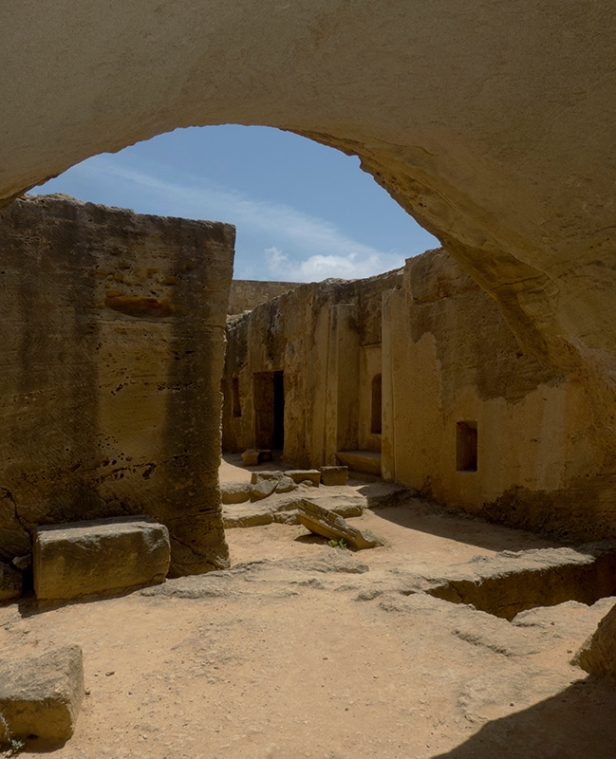
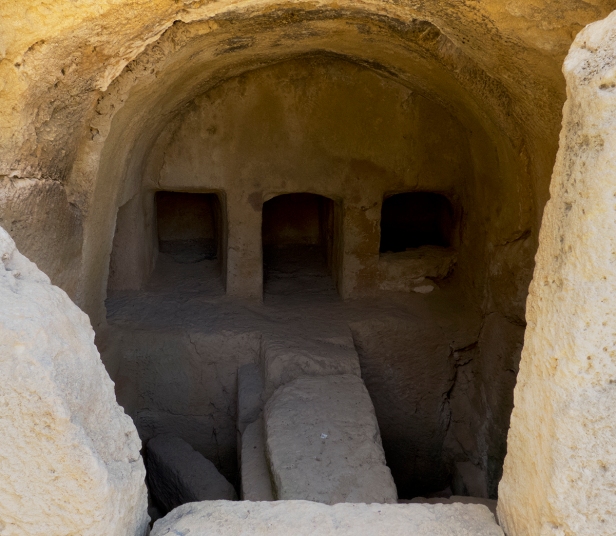
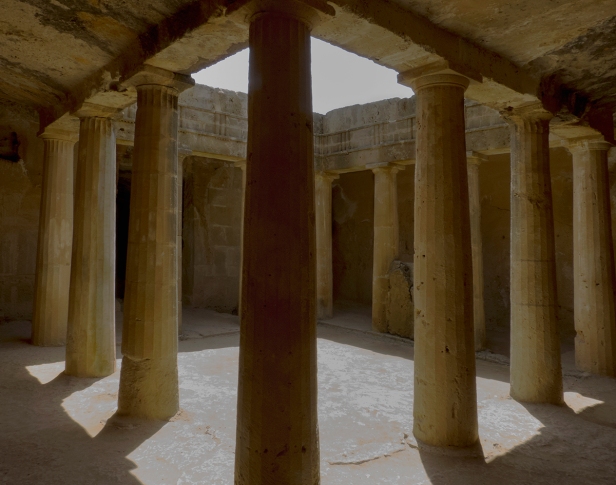
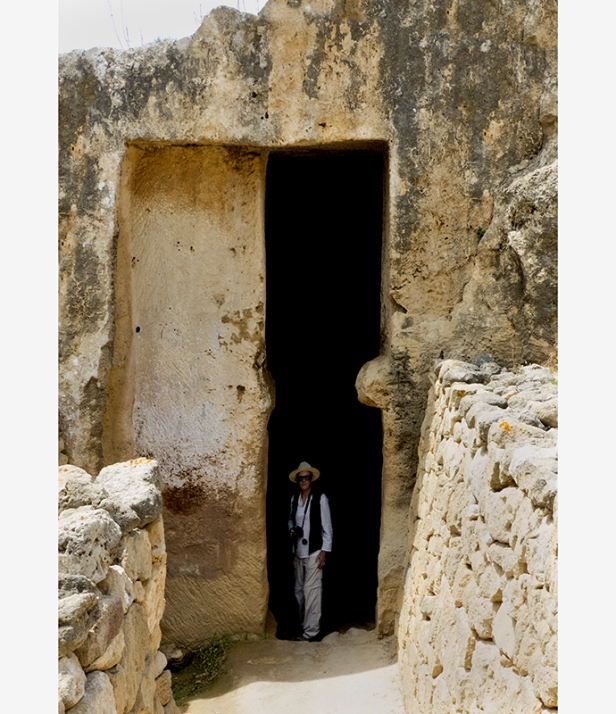

Today plenty of pigeons think the tombs make fine homes.
We were wandering down towards the busy harbour one day, on our way to do a little more time-travel, on this occasion back to the 3rd century, which was just about at the time they stopped building huge underground homes for the dead, when we were stopped by dancing. Once again on our travels we had lucked into a performance of traditional dancing, this one taking place on an outdoor stage near the entrance to a time warp back to the ancient Roman era. There were about twenty dancers and half a dozen musicians performing the traditional dances of Cyprus. The Greek influence is unmistakable, but the dances have their own Cypriot flavour that has developed over centuries. We watched entranced as the men took turns, dancing with scythes and handkerchiefs. Then it was the turn of the women. There was the feeling that this kind of dancing traditionally takes place in a bar, or a barn, or at a wedding, with tables set up for those not dancing.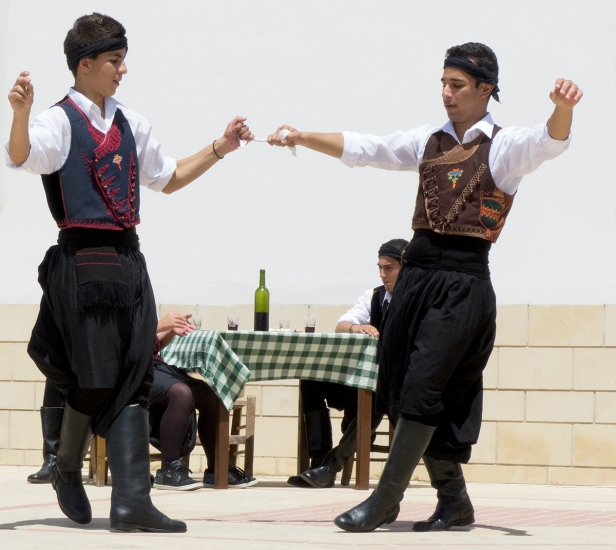

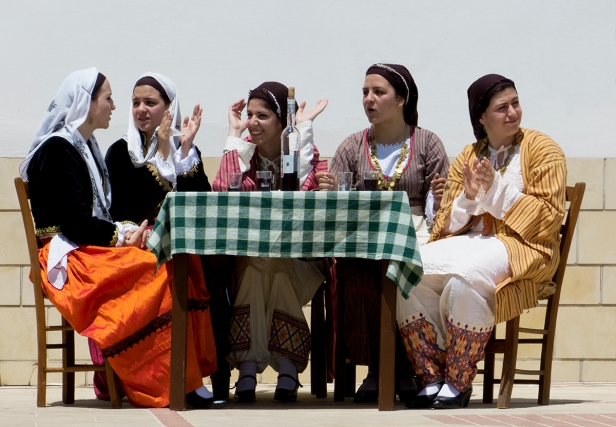
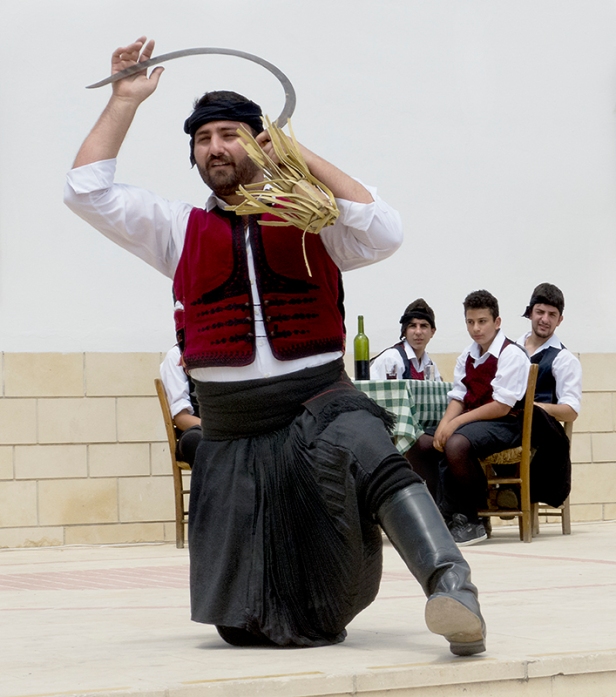


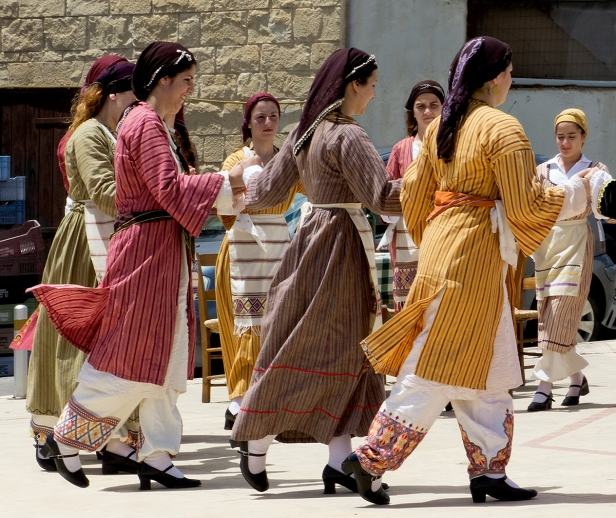
Down by the harbour in 1962 a farmer was plowing his land and discovered a most remarkable sight: mosaic floors dating back to antiquity. I imagine at the time he had no idea exactly what it was he had come across, or how far-reaching and significant the find would be. Extensive archaeological excavation unearthed the surprisingly well-preserved remains of the grand houses of the Greco-Roman Empire of the second to fourth centuries, houses of the living, not the dead. They are a testament to the wealth of the town at the time. Of greatest significance are the well-preserved mosaic tile floors. The intricate, detailed floors are made of marble and stone and depict the stories of Greek mythology. The Villa of Dionysos alone covers nearly 6000 square feet consisting of fourteen rooms. Five mansions were discovered, and although little remains of the houses the beautiful tile floors are almost completely intact. Each house is truly grand in scale covering many thousands of square feet. Archaeologists identified courtyards, reception halls, and many other facilities.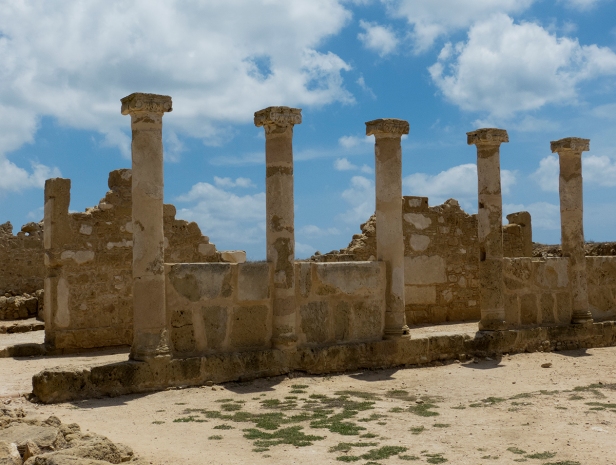
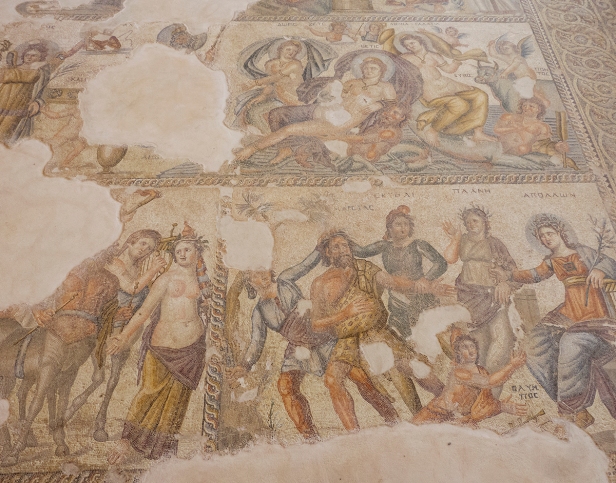
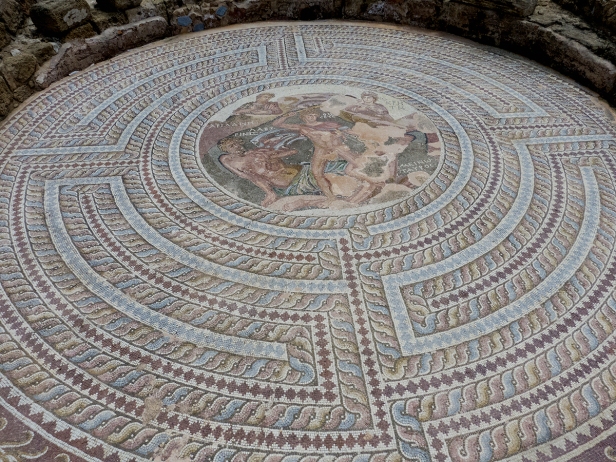
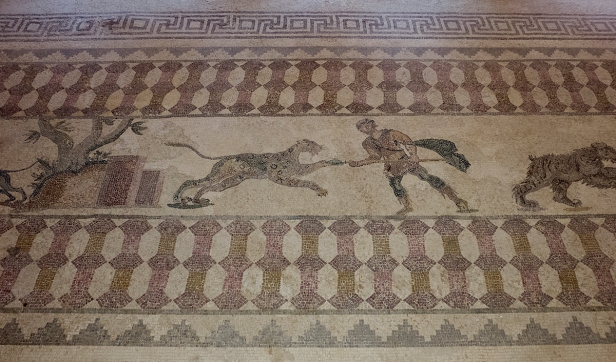
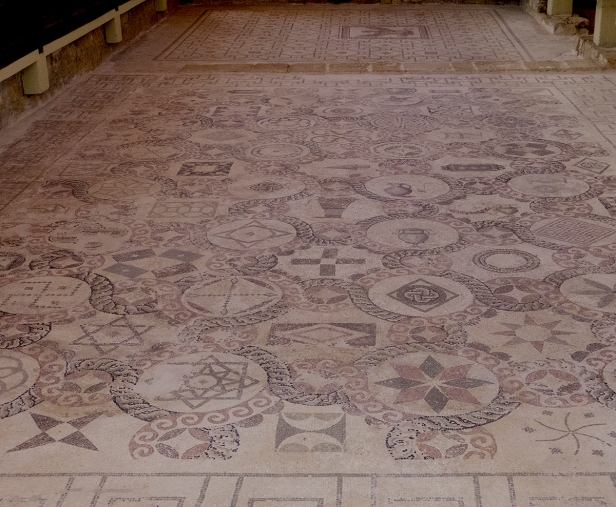
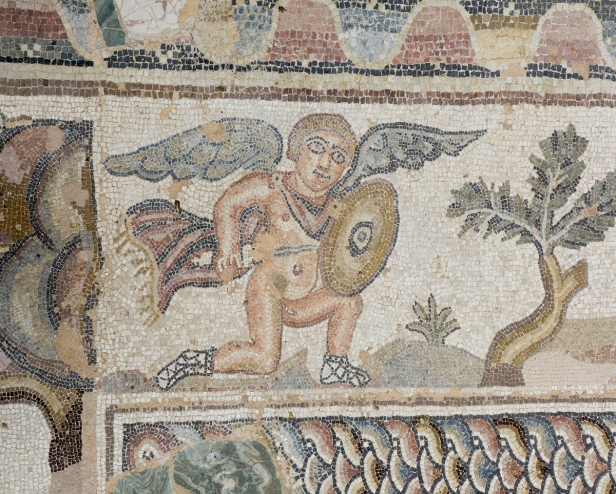
This was early days during the spread of Christianity. Paganism, and belief in the old myths still prevailed amongst about half the population, and yet with the mixing of differing beliefs and customs, apparent contradictions can be resolved. This mosaic of the birth of Dionysos could be the nativity of Jesus if you remove the wings on the head of Mercury, and change the names of those in attendance.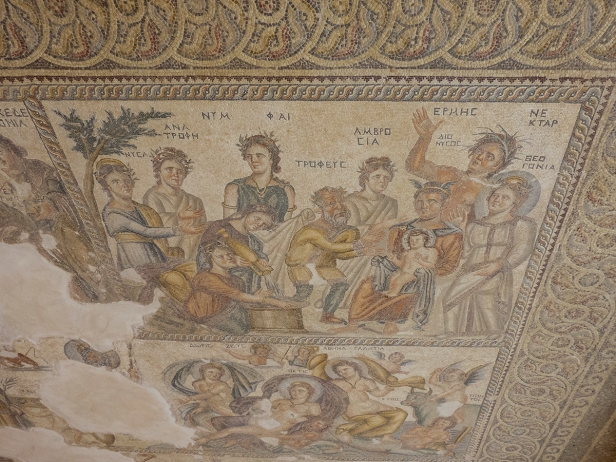
The scale of these houses is stupendous; the tiled floors works of art, created from a grand vision by skilled craftsmen. We imagined living in such ostentatious surroundings, walking daily over these beautiful floors.
And finally, in our time-travel back to ancient times, we visited the city of Kourion, founded by the Greeks in the 13th century BC and destroyed by the earthquake of 365 AD. At the time it was an important city-kingdom set in a prominent place on the coast a little west of the modern city of Lemesos.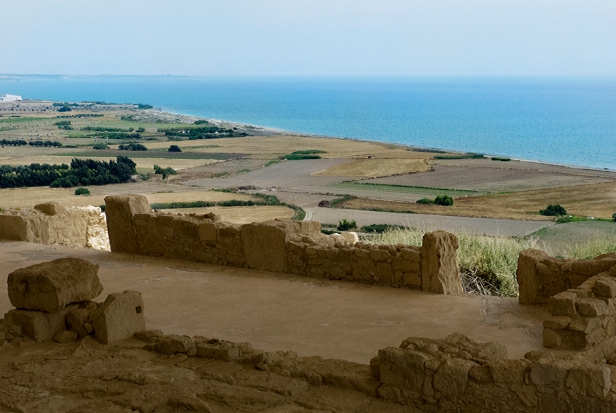
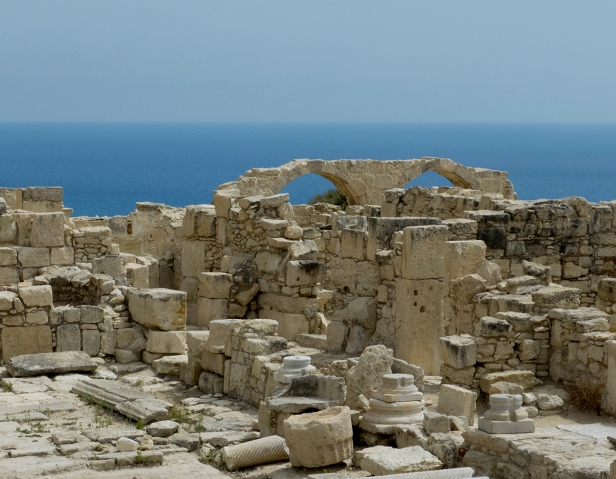

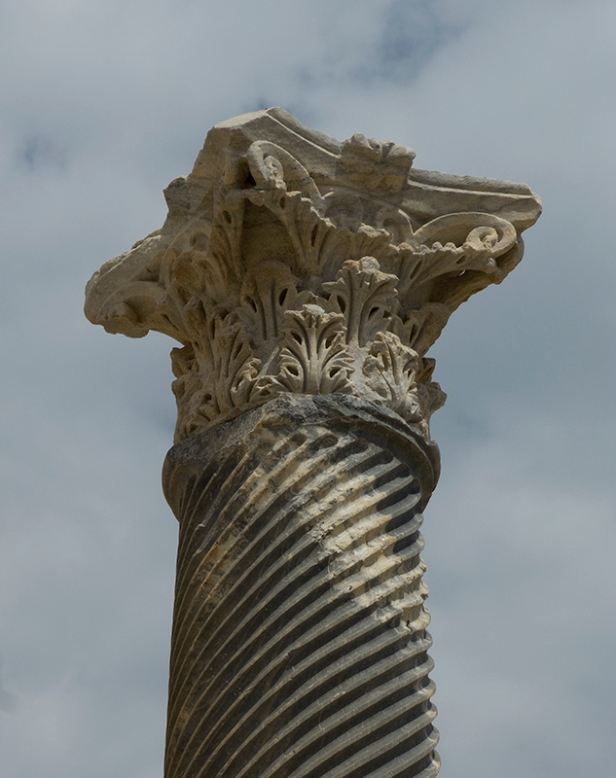
This is the remains of a hypocaust, which provided under-floor heating. The floor was built above the pillars, and the space beneath the floor, and in the walls, was heated with a wood furnace. Hypocausts were usually only found in the homes of the wealthy, and in public buildings.
If you are now thoroughly confused about the history of Cyprus, don’t worry, so am I. This island, being so strategically located at the eastern edge of the Mediterranean was coveted by, and seized by, every ancient empire and a few more recent ones. Human habitation dates back ten thousand years so every site we visited had layer upon layer of traditions, and communities, each new society overlaying the previous one while at the same time incorporating their customs in new ways. To say Kourion was founded in the 13th century BC is an over-simplification. People had lived there for a few thousand years before that. But no longer. Like everything else on this earth: it arises, it falls away. This is the final post about Cyprus. On May 28th we flew home to Vancouver. Next post: Back in our Canadian home town.
All words and images by Alison Louise Armstrong unless otherwise noted
© Alison Louise Armstrong and Adventures in Wonderland – a pilgrimage of the heart, 2010-2015.

It was Interesting to read about Aphrodite and the ‘sacred prostitutes’.
Some years ago I edited a fascinating paper for a art history expert comparing a statue of Aphrodite of Melos (Greek Island) dating 120 BCE (the last Goddess temples closed in Greece around 500 BCE) to Venus Of Wilendorf -a primitve statue and fertility symbol of a rotund/pregnant woman (dated 25,000 to 30,000 years old, pretty common image). The author used the comparison to describe the devaluation of the female over time and patriarchal reconstruction of art, pointing out the older statue was associated with Gaia, the Earth Mother, who pretty much disappeared from Greek mythology or at least became less prominent over time.
The author said that the character of Aphrodite also changed over time, to reflect changes in society.
I found her analysis quite compelling and your story brought it all back to mind.
LikeLike
I’m familiar with the Venus of Wilendorf – that must have been a fascinating article. I guess by the time the cult of Aphrodite had become established on Cyprus females had been pretty much devalued overall. I’m hopeful, somewhat, that things are finally starting to change. It’s been far too long.
Alison
LikeLike
There were pictures of some of those mosaics in my art history texts. How wonderful to see them in the light and colour of your photos!
LikeLike
Thanks Fiona. As usual we had no idea what to expect and were quite blown away by the mosaics. Both the scale, and detail, are amazing, and they’re very beautiful.
Alison
LikeLike
Another wonderful article Alison. I particularly loved the photographs of the necropolis and the mosaics. Many thanks for these and for your informative and eloquent writing – I always greatly appreciate your articles. Hariod. ❤
LikeLike
Thank you so much Hariod. The necropolis was really fascinating, and the scale and beauty of the mosaics quite unexpected.
Alison
LikeLike
I’ll bet! All the best Alison – H ❤
LikeLike
A delightful post about Cyprus which is such a fascinating country. You have captured a series of lovely images.
LikeLike
Thanks very much Otto. I’m glad you enjoyed it. It is indeed a fascinating country, with a long and complex history.
Alison
LikeLike
I have never been to Cyprus, despite living only a couple of hours away. Your pics are amazing, and a good insightful write-up! The ruins look amazing, and I want to explore them!
LikeLike
Thanks Lee. Do go! It’s a really amazing place – so much to see – ancient ruins, beautiful Byzantine churches, and great beaches. What more could you want 🙂
Alison
LikeLike
The tombs remind me of the burial sites outside of Rome at Tarquinia, same era, same concept. The Tarquinians believed that what was in their tomb houses was what they had to live with for eternity. The murals reflected lots of drinking and parties. 🙂
Aphrodite/Venus has always been one of my favorite goddesses, possibly because I found Boticelli’s Birth of Venus, um, provocative as a high school student. 🙂
Never met an ancient Greek or Roman ruin that I didn’t like.
Thanks for your series on Cyprus. I am looking forward to your blogs on Vancouver. I am starting my series on kayaking off of northern Vancouver Island this week. Our joint followers will get a double dose of BC. –Curt
LikeLike
I didn’t know about Tarquinia or we would have gone there when we were in Rome. I think the Egyptians/Ptomelmys had the same idea about the tombs being the home of the dead in the afterlife.
I have been a huge fan of Boticelli’s “Rite of Spring” and “Birth of Venus” ever since I learned about them when, like you, I was a high school student, though perhaps not for the same reason as you 🙂
It was a dream come true for me to see the originals in the Uffizi a few years ago.
Vancouver’s a dream city – looking forward to sharing it. And to reading about your kayaking trip
Alison
LikeLike
Peggy and I have been to the Uffizi as well. There is always something special about seeing an original painting that you have admired for years. As for Vancouver, I’ve only been there a couple of times but immediately fell in love with the city. –Curt
LikeLike
I am glad you gave me an out at the end as regards my lingering confusion of Cypriot history. My main take-aways were, in no order of importance: incredible preservation of two thousand year old tile floors, the consistency of birthing teams from Dionysos to Jesus, Greek dancing but not really, a doorway three times as tall as it needed to be, and you had lots of incredible weather.
What I loved most about this was the first couple of images where that little tree is growing on the site of the ancient Aphrodite temple. The tree brings a certain irreverent exuberance to the scene, as if a playful child had plunked down in a budget session of congress and begun playing with dolls. That is how I like to feel during supposedly serious moments, like that tree beside the ocean…
Michael
LikeLike
Chuckle chuckle chuckle. I think you got the main points 🙂
Yes, we had incredible weather – sunny just about every day for 2 months.
I do love your take on the little tree – it just says “look at me, am I not so much more fun than all those boring old stones?!”
Alison
LikeLike
What a detailed and interesting post. This looks like it was a fabulous trip.
LikeLike
Thanks so much Angeline. It *was* a fabulous trip – so much to discover there. I think we barely scratched the surface.
LikeLike
What an interesting post! I love places such as this, rich in history (sometimes almost too rich!) – and lovely photos. Cyprus is on my travel bucket list!
LikeLike
Thank you so much Renate. Cyprus is definitely worth visiting – so much history, and nice beaches, charming villages and friendly people.
Alison
LikeLike
Despite how exotic it sounds, Cyprus has never been on my list of places to visit. But as I may very well be in Malta for a few months this winter, perhaps I’ll pop over to Cyprus and do some exploring!
LikeLike
Oh do go, especially since you’ll be so close – it’s lovely. It was not on our list either, but a long-time friend of Don’s has a place there so off we went.
Where are you at the moment?
Alison
LikeLike
I am actually with my mom in Colorado, but just through tomorrow. Then I’m back to my “home” town of Portland for 2 weeks, then Florida, then Boston, then Ireland for the entire month of December. And then, the Laurentian mountains outside of Montreal in January. Malta is looking to be Feb. – April – as long as I’m on the road, I want warm sun and white sandy beaches for my winter! 😉
LikeLike
Wow. Sounds like you’re having an amazing time. And getting around!
Happy travels. ❤
LikeLike
Alison, what an intriguing final post on your stories from Cyprus! The more you share about the history of this Mediterranean island nation with us, the more I want to visit it. Those traditional dancers, somehow, remind me of their Greek, Turkish and Central Asian counterparts. A vestige from the ancient Silk Road, perhaps?
LikeLike
Thanks Bama, glad you enjoyed it. We found Cyprus surprisingly fascinating. We went there for a rest and because a friend offered us their house there, and discovered more than we’d imagined that’s for sure. It’s worth a visit.
I think your Silk Road suggestion is probably spot on.
Alison
LikeLike
Hi!
I just found your blog here, started to read about you and your story and I am amazed! It’s so great, that no matter what age you are, you can live your life the way you want and fullfill your dreams 🙂
But I saw, that you wrote, that you’re now coming back to Canada, so is it the end of the trip? I just started reading the blog, so maybe I missed something 😉
I just started to write my own blog, about travels and discovering the world -http://worlderingaround.wordpress.com, you can have a look if you want 🙂
Regards,
Aga
worlderginaround.wordpress.com
LikeLike
Hi Aga, nice to meet you! Yes, age is not a problem. Attitude is far more important than age. We’ve been back in Canada for a few months recovering from our travels in South America and a couple of injuries – I fractured my ankle then right after it was healed Don blew a disc in his back. He is well on the mend and we are already planning our next moves – end of November we go to Hawaii, Samoa, Fiji, Australia and New Zealand. After that? Don’t know yet. We just keep on moving, discovering the world, and ourselves.
Your blog is looking really good – a very fine beginning!
Happy travels,
Alison
LikeLike
Oh, good to know that you are better now! And good luck for you, with health and travels 🙂 Your next plans look fabulous, and I’ll be following the stories on your blog!
Enjoy every minute of the great journey,
Aga
LikeLike
Hello,Alison & Don,
Partnering with Merrill Edge, Travel Channel is pulling together our Travel’s Best Retirement Getaways package and we’d love to include your pick for the Best Getaway, as you’re the resident retiree travel expert. It’s by far our most popular feature on the site: http://www.travelchannel.com/interests/travels-best.
If you’re interested, we’d just need at least three of your top picks for “Best Places to See During Retirement.” We’re looking for roughly 50 words per destination and the more specifics, the better – why it’s great for retirees, why you picked it, why it’s popular, why it’s your favorite, or what’s different about it…we just want to showcase your expertise as a retiree travel expert.
For an example of the package, we just launched Travel’s Best Road Trips. These features are heavily promoted on our site, in social media and by our PR team and will link back to your website. The picks are also included in a slideshow: http://www.travelchannel.com/interests/travels-best/photos/best-road-trips-2014
Let me know if you have any questions. I can share more of our plan with you, if you’d like. We’d like to get your picks by Thursday, October 30, 2014. Would love to work with you on this if your schedule allows!
Best,
Michelle
LikeLike
Hi Michelle, nice to meet you. Thank you for this honour. We’d love to participate and have already started thinking about which places to include. I’ll email you for more details.
Cheers,
Alison
LikeLike
Great! We look forward to reading your picks!
Best,
Michelle
LikeLike
Love Cyprus. The Aphrodite myth is new to me, or my memory is so bad I have no traces left. Very interesting. Myth is fascinating. Terry & I were talking about the difference between religions and myths today on a ride to do some work. We can to the conclusion that myth knows it’s story and points to something, which seems closer to being accurate. Thanks for this post. 🙂
LikeLike
The Aphrodite myth was new to us too. Well for me anyway never having learned about the ancient Greek and Roman myths in school. It was fun to find out about it. I do think myth points to something, but I believe religions do too, but it’s maybe just harder to find. I find it interesting that if you dig deep enough it seems that all the great religions teach basically the same message – about love and about oneness.
Alison
xox
LikeLike
Agree about religions but think that at times the door is shut, by belief, to what they point to which Joseph Campbell aptly put as the mystic element of all religions, the common thread as you’re referring to. I have no issue with any religion, it’s fixed dogma and viewpoints that separate that is “my” issue as hypocritical as that may come across. And so I guess my lesson is tolerance even for closed minds that can’t embrace differences. ❤
LikeLike
Ah, you say it so well. I too have difficulty with fixed dogma and viewpoints that separate. It’s the reason I have little time for any religion. At the same time I remind myself that people need to experience what they need to experience. I’m glad I don’t live in that world 🙂
A. ❤
LikeLike
Very, very interesting! What amazing history, ruins, culture and of course photos! The history on Aphrodite is so interesting – My favorite painting, which I luckily got to see up close almost 10 years ago is Boticelli’s Birth of Venus. I find all things Aphrodite quite fascinating – who doesn’t find love and beauty fascinating, right?
Another beautiful destination, and more incredible dancers captured – nicely done!
~ Andrea ❤
LikeLike
Thanks Andrea. I too love Boticelli’s Birth Of Venus, and of course went to see it when we were in Florence. Definitely one of the world’s great works of art. It was fun researching for this piece. I didn’t know the myth of Aphrodite, and the ruins are not all that spectacular but when I learned about the myth and the ritual practices of the time of course I had to include it.
Alison ❤
LikeLike
What an interesting country. The Greeks have left behind some amazing influences. Always longed to go to Cyprus, and will use your post when I make my itinerary. 🙂
LikeLike
Thank you so much. Yes, it is an interesting country, very rich history. I have also written 2 previous posts on Cyprus in case you missed them. It’s definitely worth visiting. We didn’t make it to the Turkish sector but heard it’s very interesting and has the best beaches so you might want to put that on your itinerary too.
I’ve been looking around your blog. Fabulous photos!
Alison
LikeLike
Another case of excellent mosaics discovered by accident Alison. These mosaics are particularly nice. ~James
LikeLiked by 1 person
We were so impressed by these mosaics. They’re huge and intricate and beautiful. I think my photos don’t do them justice.
Alison
LikeLike